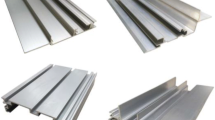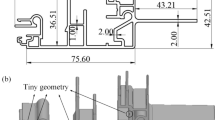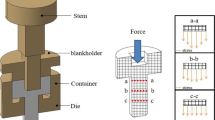Abstract
In extrusion practice surface quality problems like flow lines with thin and varying thicknesses of complex profiles are experienced. Minimization of temperature variance inside the forming zone and velocity variation across the face of the die are particularly important during the metal flow in order to maintain a good quality finish. Several parameters such as shape, depth of pocket, location of die hole and local bearing lengths can be altered to minimize these effects, but fundamental understanding between these parameters and homogeneity of metal flow are very limited in the literature. This study investigates the influence of above-mentioned parameters on the flow behaviour during extrusion for simple and more complex geometries.




















Similar content being viewed by others
References
Fang G, Zhou J, Duszczyk J (2008) Effect of pocket design on metal flow through single-bearing extrusion dies to produce a thin-walled aluminium profile. J Mater Process Technol 199:91–101
Fang G, Zhou J, Duszczyk J, Wu XK (2008) FE simulation of extrusion to produce a thin-walled wide profile through a spreading pocket die. Key Eng Mater 367:63–70
Golovko O, Grydin O (2006) Method for pocket die design on the basis of numerical investigations of aluminium extrusion process. Metalurgija 45(3):155–161
Hansson S (2006) Simulation of stainless steel tube extrusion. Ph.D. thesis, Lulea University, Sweden
Li Q, Smith CJ, Harris C, Jolly MR (2003) Finite element investigations upon the influence of pocket die designs on metal flow in aluminium extrusion Part 1. Effect of pocket angle and volume on metal flow. J Mater Process Technol 135:189–196
Li Q, Smith CJ, Harris C, Jolly MR (2003) Finite element investigations upon the influence of pocket die designs on metal flow in aluminium extrusion Part 2. Effect of pocket geometry configurations on metal flow. J Mater Process Technol 135:197–203
Muramatsu T, Zhang S, Lim B, Yong S (2005) Study on flexi-extrusion forging technique by using intelligent actuating tooling. SIMTech technical report
Peng Z, Sheppard T (2005) Effect of die pockets on multi-hole die extrusion. Mater Sci Eng A 407:89–97
Yuan Z, Li F, He Z (2005) Effects of guiding angle on plastic metal flow and defects in extrusion of aluminium alloy. J Mater Science Technol 24:256–260
Author information
Authors and Affiliations
Corresponding author
Rights and permissions
About this article
Cite this article
Kathirgamanathan, P., Neitzert, T. Optimization of pocket design to produce a thin shape complex profile. Prod. Eng. Res. Devel. 3, 231–241 (2009). https://doi.org/10.1007/s11740-009-0161-5
Received:
Accepted:
Published:
Issue Date:
DOI: https://doi.org/10.1007/s11740-009-0161-5




